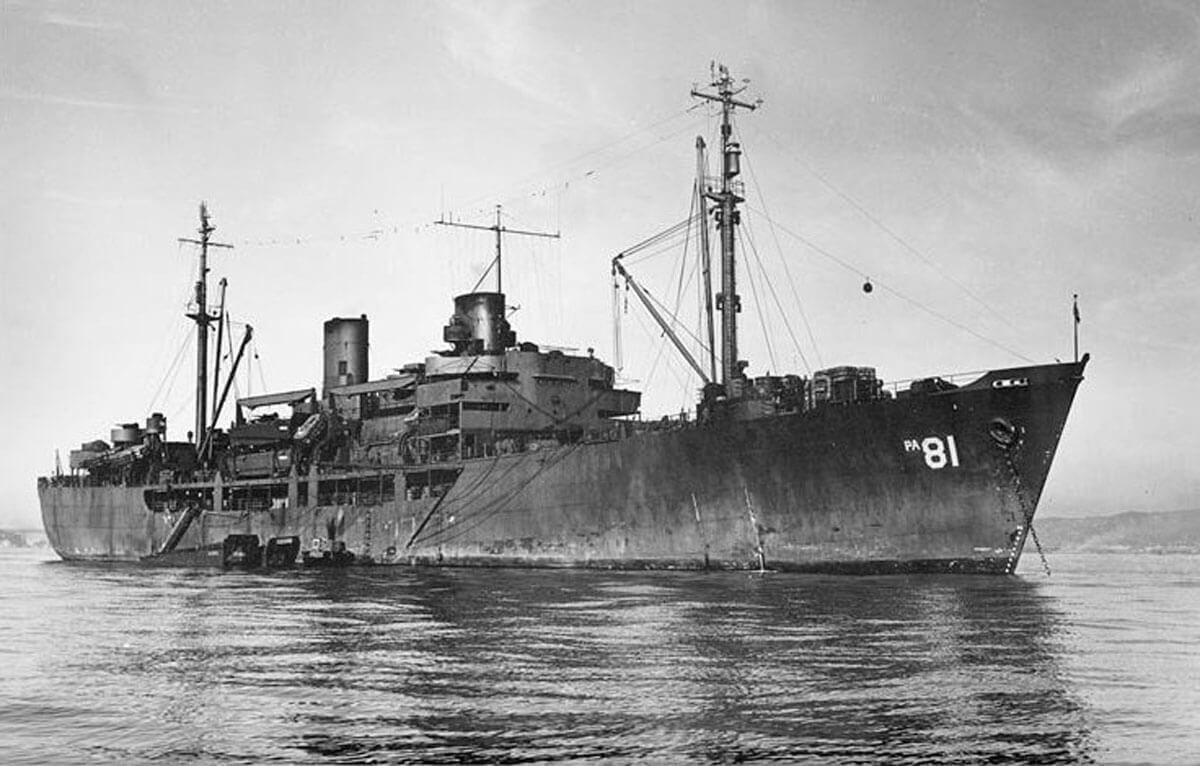Gilliam-Class Attack Transports

The first of the 32 Gilliam-class attack transports was launched on March 28, 1944. These vessels were specially designed for unloading cargo over the side into landing craft that were carried on the transport. Their purpose was to transport troops and military equipment for the execution of amphibious invasions on foreign soil using smaller amphibious assault boats.
Gilliam-class transport ships were heavily armed with anti-aircraft weapons to protect their cargo and the troops they carried. They saw little combat but served a vital support role during World War II. The USS Gilliam served as a target for U.S. nuclear weapons testing.
History of Gilliam-Class Vessels
Consolidated Steel Corporation in Wilmington, California built the USS Gilliam in 1944 under a U.S. Maritime Commission contract. The U.S. Navy acquired the transport on July 31, 1944 and commissioned it as APA-57 the following day.
On October 16, 1944 Gilliam left San Francisco Bay carrying 750 army troops to New Guinea. Gilliam transported troops to the Philippines in support of the country’s re-conquest by the U.S. and served in the Battle of Leyte Gulf as a receiving ship for the crew of damaged or lost warships and injured personnel. Gilliam also took part in the assault on Okinawa. When the war ended the transport was used to ferry occupation troops to Japan and to take U.S. troops home as part of Operation Magic Carpet.
After the war USS Gilliam was chosen as a target vessel for Operation Crossroads, a series of nuclear weapons tests conducted during the summer of 1946 by the U.S. government. The purpose of the testing was to study the effects of nuclear weapons on ships, material, and equipment.
Although 3 detonations were initially planned, only 2 were actually carried out. Able was detonated at an altitude of 520 feet on July 1, 1946 and Baker was detonated 90 feet under water on July 25, 1946. Each detonation had a yield of 23 kilotons. Charlie, the third originally-planned detonation, was canceled.
Gilliam was made ready for testing in Pearl Harbor after its arrival on February 16, 1946. She moored aft of Nevada, the intended Able target. The bomb instead detonated close to Gilliam and the ship sank in less than 2 minutes. Several other U.S. ships were sunk by Able – USS Anderson, USS Lamson, and USS Carlisle – along with the Sakawa, a surrendered Imperial Japanese Navy cruiser.
Gilliam-Class Technical Specifications
Gilliam transport ships were constructed in 1944 and 1945. These were smaller ships with shallow drafts, intended from the start for military use and designed to carry a great deal of combat equipment along with passengers. Gilliam-class technical specifications included the following:
- Dimensions: 426 ft. x 58 ft. x 15.5 ft.
- Tonnage: 7,000-8,000 tons fully loaded; 4,000-5,000 tons light
- Armament: (1) 5”/38 dual purpose gun; (10) 20mm AA guns; 2×2 40mm AA guns
- Machinery: 2 Westinghouse turboelectric turbines; 2 Babock and Wilcox boilers
- Max speed: 16.5 knots
- Cargo: 2,000-3,000 tons; 80,000-90,000 cubic feet
- Complement: 250-300
- Passengers: 800-900
Gilliam-Class Transports and Asbestos Exposure
Navy veterans are one of the worker groups most commonly diagnosed with the asbestos cancer mesothelioma. Their asbestos exposure can be traced back to service onboard ships like the Gilliam, which had hundreds of different asbestos products.
The Navy valued asbestos because it was lightweight, heat resistant and fireproof. The use of asbestos for pipe and equipment insulation, brakes, gaskets, construction materials, and other applications allowed ships to travel faster and further and to carry more armaments. Exposure to asbestos, however, resulted in many veterans developing asbestos diseases many years after their initial exposure.
The companies that supplied the Navy with asbestos products did not warn about asbestos health risks. This omission makes them potentially liable for losses suffered by Navy vets with mesothelioma and lung cancer.
Belluck & Fox, LLP obtains justice for Navy veterans by holding the asbestos companies responsible for their failure to warn. We research service records and ship logs and interview veterans and their shipmates to determine how asbestos exposure occurred and which companies supplied the asbestos. We’ve obtained excellent results for Navy vets, including a single recent verdict worth more than $30 million.
Learn more about how our nationally-recognized asbestos attorneys help veterans and their families during a free case review with Belluck & Fox, LLP.
Sources:
- Global Security.org: APA-57 Gilliam-class attack transports
- The Pacific War Online Encyclopedia: Gilliam Class, US Attack Transports
- Live Leak: Operation Crossroads 1946 Nuclear Tests
